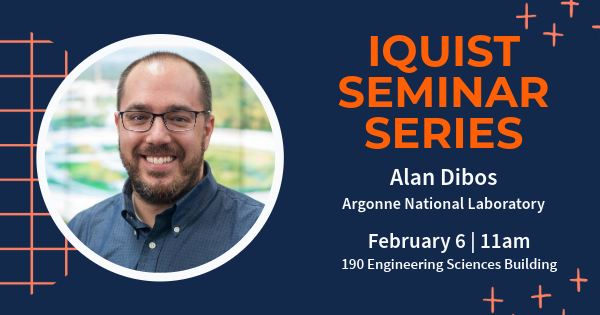
IQUIST Seminar: "Optical relaxation dynamics of nanocavity-coupled erbium ensembles," Alan Dibos, Assistant Scientist, Argonne National Laboratory
- Event Type
- Seminar/Symposium
- Sponsor
- IQUIST
- Location
- 190 Engineering Sciences Building, 1101 W Springfield Ave, Urbana, IL 61801
- Date
- Feb 6, 2024 11:00 - 11:50 am
- Speaker
- Alan Dibos, Assistant Scientist, Nanoscience/Center for Molecular Engineering, Argonne National Laboratory
- Contact
- Hannah Stites
- hstites2@illinois.edu
- Phone
- 217-300-4072
- Views
- 275
- Originating Calendar
- IQUIST Seminar Series
Optical relaxation dynamics of nanocavity-coupled erbium ensembles
Abstract: Tailoring the interaction between optical emitters and their electromagnetic environment is of both fundamental scientific interest and practical relevance for applications such as quantum communication and quantum information processing. By tuning the photonic density of states, one can drastically modify the emission properties of these emitters, a phenomenon that underpins the thriving research area of cavity quantum electrodynamics. In this talk, we will first present our rare earth doped nanocavity platform that is being pursued for future quantum optical memory devices operating at cryogenic temperatures. Our spin qubit system consists of Er3+ ions with a natural optical transition in the telecom (~1520 nm), but the long optical lifetime of these ions (order of milliseconds) necessitates the use of an optical cavity to greatly enhance the emission rate. More specifically, we grow thin film Er3+-doped titanium dioxide (TiO2) atop silicon-on-insulator wafers and fabricate small mode volume photonic crystal cavities via etching through both the TiO2 and Si device layers. We have thus far demonstrated that when the optical cavity is resonant with optical transition of the Er3+ions, the optical lifetime can show an enhancement (Purcell factor) up to several hundred [1]. However, in addition to quantum communication applications, we can use the long optical lifetimes of rare-earth ions for more fundamental optical decay modification experiments [2]. For our system, the ensemble of Er3+ emitters that couples to the cavity exhibit a much broader inhomogeneous linewidth than the cavity. When the optical cavity is tuned through the Er3+ inhomogeneous distribution, the resultant Purcell factor exhibits an anomalous slowing of the decay when the cavity is resonant with the center of the distribution. We will examine the experimental Purcell factor dependence on resonant laser pump power, as well as the spectral dependence of the PLE emission. We will discuss our attempts to capture qualitative aspects of this decay rate suppression using a semi-classical model of non-interacting emitters mediated by a common cavity. Finally, we will discuss a recent material synthesis development to make our Er3+:TiO2 system potentially more scalable for foundry-level deployment [3].
[1] A. M. Dibos et al., “Purcell enhancement of erbium ions in TiO2 on silicon nanocavities,” Nano Lett. 22, 6530 (2022).
[2] M. T. Solomon et al. “Anomalous Purcell decay of strongly driven inhomogeneous emitters coupled to a cavity.” arXiv, DOI: 10.48550/arXiv.2309.16641 (2023).
[3] C. Ji et al. “Nanocavity-mediated Purcell enhancement of Er in TiO2 thin films grown via atomic layer deposition.” arXiv, DOI: 10.48550/arXiv.2309.13490 (2023).Bio: Dr. Dibos is an expert in nanofabrication and cryogenic measurement of low-dimensional optical nanostructures. His research interests include optical coupling of photonic and plasmonic nanocavities to atom-like defect centers in solid-state hosts. The goal is to modify the spectral properties, increase photon emission rates, and improve the photon collection efficiency for quantum information science applications. To that end, Dr. Dibos works within two different divisions: (1) the Nanofabrication and Devices (NFD) group within Argonne’s Center for Nanoscale Materials (CNM) a DOE nanoscience user facility with a premier cleanroom, and (2) the Center for Molecular Engineering as a principal investigator (PI) on a Q-NEXT project investigating telecom quantum memories based upon solid-state spins at low temperatures. Dr. Dibos is also lead-PI on a LDRD project involving incorporation of on-chip superconducting nanowire single photon detectors (SNSPDs) to increase device functionality.
For Zoom link you may check the IQUIST calendar weekly email or contact Hannah Stites (hstites2@illinois.edu). To subscribe to our weekly email for event announcements, please go to https://lists.illinois.edu/lists/subscribe/iquist-announcements.